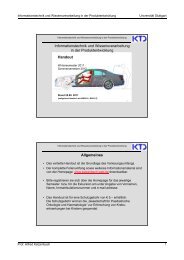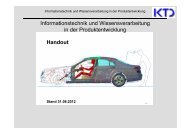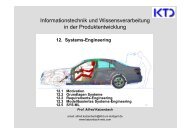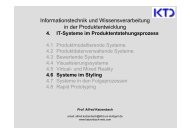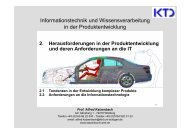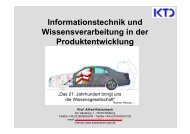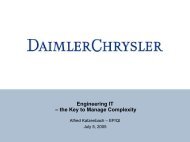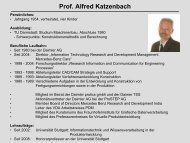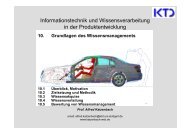Informationstechnik und Wissensverarbeitung in der ...
Informationstechnik und Wissensverarbeitung in der ...
Informationstechnik und Wissensverarbeitung in der ...
Sie wollen auch ein ePaper? Erhöhen Sie die Reichweite Ihrer Titel.
YUMPU macht aus Druck-PDFs automatisch weboptimierte ePaper, die Google liebt.
<strong>Informationstechnik</strong> <strong>und</strong> <strong>Wissensverarbeitung</strong> <strong>in</strong> <strong>der</strong> Produktentwicklung<br />
Universität Stuttgart<br />
<strong>Informationstechnik</strong> <strong>und</strong> <strong>Wissensverarbeitung</strong> <strong>in</strong> <strong>der</strong> Produktentwicklung<br />
3. 4 Prozesse <strong>und</strong> Methoden <strong>in</strong> <strong>der</strong> Produktentwicklung - Requirements Eng<strong>in</strong>eer<strong>in</strong>g<br />
Qualitätskriterien für Anfor<strong>der</strong>ungen<br />
Rechtliche Verb<strong>in</strong>dlichkeit<br />
Verb<strong>in</strong>dlichkeit<br />
Pflicht<br />
Empfehlung<br />
Wunsch/Option<br />
Schlüsselwort<br />
(deutsch)<br />
muss (darf<br />
nicht)<br />
sollte / soll<br />
kann<br />
shall/must, (shall not)<br />
should<br />
can<br />
Schlüsselwort<br />
(englisch)<br />
Die rechtliche Verb<strong>in</strong>dlichkeit ist<br />
e<strong>in</strong>deutig gekennzeichnet,<br />
wenn e<strong>in</strong>es <strong>der</strong> aufgeführten<br />
Schlüsselwörter verwendet<br />
wurde.<br />
Prof. Alfred Katzenbach W<strong>in</strong>tersemester 2009 /<br />
Sommersemester 2010<br />
39<br />
<strong>Informationstechnik</strong> <strong>und</strong> <strong>Wissensverarbeitung</strong> <strong>in</strong> <strong>der</strong> Produktentwicklung<br />
3. 4 Prozesse <strong>und</strong> Methoden <strong>in</strong> <strong>der</strong> Produktentwicklung - Requirements Eng<strong>in</strong>eer<strong>in</strong>g<br />
Qualitätsregeln <strong>der</strong> Anfor<strong>der</strong>ungsdef<strong>in</strong>ition<br />
Vere<strong>in</strong>zeln Sie Ihre Anfor<strong>der</strong>ungen. Formulieren Sie <strong>in</strong> e<strong>in</strong>em (Ab-)<br />
Satz nicht mehr als e<strong>in</strong>e Anfor<strong>der</strong>ung. Vermeiden Sie Anfor<strong>der</strong>ungen <strong>in</strong><br />
Nebensätzen.<br />
Formulieren Sie die Anfor<strong>der</strong>ung im Aktiv.<br />
Vermeiden Sie Weak Words (aber, allzu, absolut, an<strong>der</strong>e, äußerst,<br />
usw.) sowie qualitative Adjektive<br />
Ordnen Sie mögliche Informationen den Anfor<strong>der</strong>ungen zwar zu, aber<br />
machen sie diese e<strong>in</strong>deutig als Information kenntlich.<br />
Achten Sie auf implizite Annahmen <strong>in</strong> Anfor<strong>der</strong>ungen.<br />
Prof. Alfred Katzenbach W<strong>in</strong>tersemester 2009 /<br />
Sommersemester 2010<br />
40<br />
Prof. Alfred Katzenbach 20



